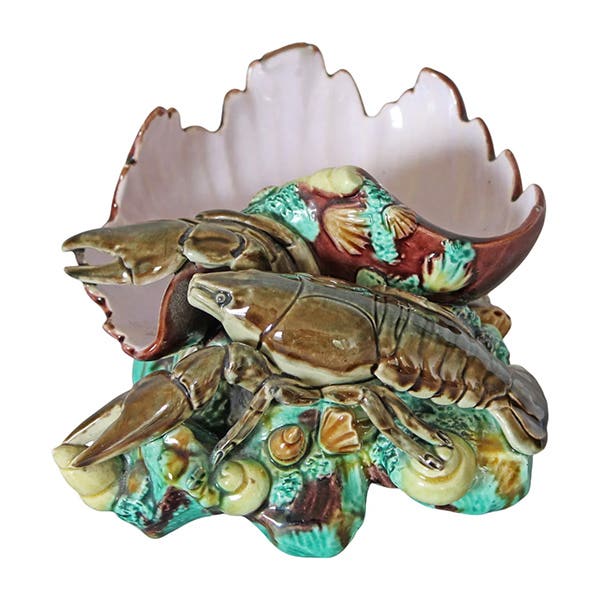Shine On! Simple Tips to Keep Glass & Ceramics Beautiful
Keep your glass and ceramic antiques looking great with these easy and simple tips from the pros.
Glass and ceramic objects can be maintained for years of use and enjoyment provided that some basic care and attention is given to their preservation. The Henry Ford conservation staff has compiled the following information to help you care for objects and collections. The first step in the care of collections is to understand and minimize or eliminate conditions that can cause damage. The second step is to follow basic guidelines for care, handling and cleaning.
CAUSES OF DAMAGE
Glass and ceramics are among the most durable antique collectibles. Breakage is by far the most common form of damage that occurs to both. Improper use, display, cleaning or repair can cause additional damage in the form of stains and discoloration. In rare instances, poor manufacture or harsh environmental conditions lead to degradation.
CERAMICS
Ceramics can become permanently stained by a variety of factors including inappropriate cleaning, repairs or careless use. Porous, unglazed or cracked ceramics can develop stains as a result of being soaked in water during cleaning. The absorption of colored materials such as foodstuffs, soil from potted plants or rust from contact with metal objects can also cause staining. In addition, the use of inappropriate or poor quality adhesives and paints during the restoration process can also result in irreversible discoloration.
Antique ceramic dishes and bowls should never be heated beyond room temperature. Elevated temperatures can cause darkening of already existing stains and sudden changes in temperature can promote the development of cracks.
In the case of archaeological ceramics, damage can be caused by the presence of salts that have been absorbed into the object from the soil in which it was buried. These salts can absorb moisture from the air when humidity levels are high. This absorption of moisture causes the expansion of the salts, which can lead to cracking or delamination of the ceramic object. The primary method for preserving archaeological ceramics is to provide a stable environment.
GLASS
In rare instances, a damaging condition called “weeping glass” occurs. Weeping glass manifests itself in the form of droplets of moisture that form on the surface of a glass object. These droplets of moisture can actually leach out unstable components of the glass producing an alkaline solution. If these alkaline droplets remain on the surface of the glass for a long period of time the surface will develop a fine network of cracks. This phenomenon is referred to as “crizzling.” Both crizzling and weeping are believed to be the result of improper formulation during glass manufacture.
Glass can also be permanently damaged by lengthy exposure to acidic or alkaline conditions such as in the case of archaeological glass. Glass that has been buried in the soil for long periods of time develops a matte, scaly and “iridescent surface.” In the case of archaeological antiques, the iridescent scaly surface has become a prized aesthetic quality that is actually desirable for collectors of archaeological glass. The primary method for stabilizing damaged glass is to provide a stable environment.
GUIDELINES FOR CARE HANDLING
The primary cause of damage to both glass and ceramic objects is mishandling. Careless handling can result in breakage, chips and scratches that mar the beauty of glass and ceramic antiques.
The careful handling and storage of glass and ceramic objects is the surest way to provide protection. Always use two hands when lifting or moving objects, being careful to lift them from their strongest points. Never lift objects by their by handles or spout. This is particularly important in the case of objects that have been repaired previously. Even the best repairs cannot completely restore the structural strength to a broken glass or ceramic item.
Whenever possible, stacked items should be cushioned using felt, soft cloth, or polyester padding to avoid abrasion of decorative surface elements. Care should also be taken to avoid rubbing gilded or iridescent glass surfaces since they can be easily worn off.
DISPLAY
The use of spring-type metal plate hangers should be avoided. These hangers place a great deal of stress on objects and can lead to the development of cracks. Metal hangers can also scratch the surface of the object. Plate stands constructed of hard plastic or painted wood that allow the object to rest at a tilted angle are preferable (these stands are easily found at craft stores).
CLEANING CERAMICS
Although ceramics are generally considered to be stable materials, a certain amount of caution must be used when cleaning them. Archaeological and low-fired porous ceramics should only be cleaned by a trained conservator. The majority of ceramic items however, can be successfully cleaned provided that a few basic instructions are followed.
Some antique ceramics contain fragile painted or gilded surface decoration, which can be removed or damaged by harsh cleaning solutions. It is important to use only diluted cleaning solutions, applied with soft cloths during cleaning. Antique ceramics should never be soaked in any liquid. Prolonged soaking and uneven drying can lead to staining of ceramics. This is particularly probable in items that are chipped, scratched or have cracked glazes. Lastly, automatic dishwashers should never be used to clean antique ceramics.
Recommended materials for cleaning ceramic objects include mild detergents in water. The detergents most commonly used at the Henry Ford Museum are Triton X-100, Vulpex and Orvus. All three products are available from Conservation Resources International.
A mixture of ethanol (ethyl alcohol) and water 1:1 can also be used for cleaning. Before proceeding to clean an object, it is important to inspect and test the object to make sure that no elements will be removed or damaged during cleaning. Examine the object to determine if there is any flaking gilding or paint that could be wiped away during cleaning. Once it has been determined that it is safe to proceed with cleaning, the cleaning solution should be tested in a small inconspicuous area to ensure that decorative designs will not be damaged.
Dilute detergents (approximately 1% in water) should be applied using a soft cloth or cotton balls. The residual detergent should be removed by rinsing with distilled water applied also with a cloth or cotton balls. In both instances, the cloth should be damp not wet. The object should then be allowed to air dry. Additional cleaning involving the removal of tenacious stains and dirt should be left to a professional conservator.
CLEANING GLASS
Glass can be cleaned in much the same manner as ceramics, with the addition of dilute ammonia as a cleaner. Weeping glass and archaeological glass should only be cleaned by a professional conservator.
CERAMIC REPAIR
Choosing an adhesive for a ceramic object is not always a simple task since it depends on the porosity and overall condition of the object. A poor choice can result in irreparable staining. As such, it is recommended that a conservator be consulted.
GLASS REPAIR
Archaeological glass, painted glass and glass photographs can be easily damaged by inappropriate repairs and, therefore, should be repaired only by professional conservator. The majority of other types of glass objects can be safely repaired in the following manner:
The most commonly used adhesive for the repair of glass objects is epoxy. The adhesive used most often at the Henry Ford Museum is Hxtal (available from Conservation Resources International LLC.). Hxtal is a strong clear adhesive that is relatively light stable. The major disadvantage to using epoxies is that they discolor with time and exposure to light. Hxtal is one of the most stable epoxies available. Many commercially available epoxies discolor within a short period of time resulting in unsightly repairs.
When repairing a broken glass object, care should be taken to avoid abrading broken edges while trying to align them. Abraded edges will prevent proper alignment during repair. Once the adhesive has been applied to all broken edges the pieces should be aligned and secured until the adhesive sets. Clear adhesive tape or strapping tape works well to hold fragments together as the adhesive cures. Residual adhesive should be removed prior to curing using acetone that is applied with a soft rag or cotton swabs. The adhesive should be allowed to set for at least 72 hours prior to removal of the adhesive tape.
Once a glass object has been repaired using epoxy, it should be kept out of direct sunlight. Sunlight will accelerate the yellowing of the adhesive. Although epoxy is a strong adhesive it may not withstand prolonged soaking. The object should not be soaked in liquids as they may loosen the mended area.
ENVIRONMENT
It is preferable to store damaged and unstable antiques such as archaeological objects and weeping glass in areas where temperature and humidity levels can be controlled and monitored. The recommended temperature and humidity levels are as follows:
Weeping Glass: Temperature 65-70 degrees Fahrenheit; Relative Humidity: 40%
Crizzling Glass: Temperature: 65-70 F; Relative Humidity: 55%
Archaeological Ceramics: Temperature: 65-70 F; Relative Humidity: 45%
It is critical to avoid fluctuations
While precise control of temperature and humidity is desirable, it is not always practical in homes. Damage should be minimized by avoiding extremes in temperature and humidity. This can be done by ensuring that objects are kept away from heat sources such as furnace vents, fire places, warm lights, direct sunlight and internally lit display cases. Inexpensive temperature and humidity indicators can be purchased from conservation suppliers.
The Henry Ford (also known as the Henry Ford Museum of American Innovation and Greenfield Village, and as the Edison Institute) is the largest indoor-outdoor museum complex in the U.S., located in the Detroit suburb of Dearborn, Michigan. For more information: www.thehenryford.org; or call 313-982-6001 or 800-835-5237.








